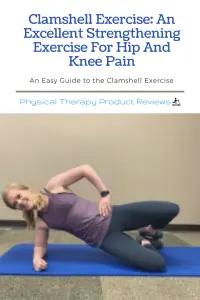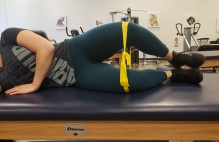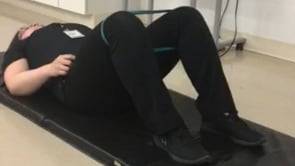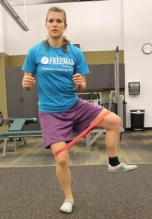The Clamshell is an excellent exercise for hip and knee pain. It is one of the most commonly prescribed exercises in physical therapy and is popular in workouts. The clamshell not only works the muscles in your hips but also helps stabilize the entire leg, including the knee and ankle.
 There are many different variations of the exercise which we’ll discuss in detail. There are also many different reasons for performing and times that this exercise should be avoided.
There are many different variations of the exercise which we’ll discuss in detail. There are also many different reasons for performing and times that this exercise should be avoided.
It’s important to note that you can make this exercise easier or harder depending on what you want out of it. We also teach you how to make this exercise easier to do and how to make it more challenging to build up muscle faster. The Clamshell should be a part of any exercise and rehab routine and we’re here to show you why.
What is the Clamshell Exercise?
The clamshell is a great hip exercise that not only works the hips but also helps to strengthen and stabilize the entire leg. The clamshell strengthens your glutes and the deep rotators of the hips.

The primary way of performing this exercise is by lying on your side with your knees bent to nearly 45 degrees. Without rotating the spine, lift the top knee towards the ceiling as far as you comfortably can. This exercise is commonly performed with a resistance band around the knees to make it more challenging.
Who Benefits from Doing Clamshells?
The clamshell is a great hip exercise that can be modified to fit anyone’s needs and abilities. While the clamshell primarily works for those with hip or knee pain, it also helps with pelvic stability and strength as well as back and even a little bit of core.
Some common injuries that would benefit from adding clamshells to their exercise routine include:
- Hip Bursitis
- Glute Tendonitis
- Greater Trochanteric Pain Syndrome
- A total hip replacement and total knee replacements
- IT Band Syndrome
- Lumbar radiculopathy or Sciatica
- Low back pain such as a herniated disc or stenosis
- Hip and knee arthritis
If you have any injuries that affect your hip or knee function, clamshells are a great way to help strengthen the area without putting undue stress on it.
Who Should Avoid Performing a Clamshell for Hip Strengthening
For the vast majority of patients, the clamshell exercise is safe and effective to perform. It’s the amount of resistance that may need to be adjusted either up or down.
There are a few groups of people who should avoid this exercise and probably strengthening exercises in general. These include:
- Anyone with a recent surgery that has not been cleared for exercise
- Anyone with a recent hip fracture that has not been cleared for exercise
- Anyone with a recent onset of cancer in the bones or area of the hip
- Anyone with a recent onset of Avascular Necrosis
What Muscles Does a Clamshell Exercise Work?
The clamshell exercise is a great hip strengthening and stabilization exercise. The clamshell primarily works the Gluteus Medius and Gluteus Maximus muscles along with the deep rotators of your hip including:
- Piriformis
- Obturator Internus and Externus
- Gemellus Inferior and Superior
- Quadratus Femoris
The Clamshell exercise also has one of the best ratios of Gluteus Medius to Tensor Fascia Latte (TFL) activation across all of the glute strengthening exercises. This means that for this exercise the Glutes are working much harder than your hip flexors which is a key for many of our hip strengthening exercises.
How To Make the Clamshell Easier
If you’re just starting out with clamshells, it’s important to start out easy. There are a few ways that this exercise can be made easier or more challenging depending on your needs and abilities.
One way of making clamshells less difficult is to not use any resistance. If you have pain when you use a theraband around the knees then make sure that you can do it pain-free without resistance first.
If performing this exercise is still difficult, then you can perform this in an anti-gravity position. Lie on your back with your knees bent and perform the exercise one leg at a time.

How to Make the Clamshell Exercise Harder
While clamshells are a great way to strengthen your hip, you may find that it is not challenging enough. There are a few ways in which this exercise can be made more difficult:
- Use a resistance band around the knees to make it more difficulty
- Lift your leg and hold it in the air as you perform the clamshell movement
- Try it on your hands and knees with a resistance band around the legs
- Try it standing with a resistance band around the knees
- Finally, to make it bout as hard as you can, try it standing on a Bosu ball with a resistance band around the legs

Why The Clamshell is a Great Exercise
It’s no secret that we love the clamshell exercise just about any hip and knee strengthening program. Here are the main reasons that we love this exercise
It’s Inexpensive
It’s very easy to perform and requires no equipment. The cost of performing this exercise is next to nothing. You can do clamshells almost anywhere with ease, including on the road traveling.
You Can do it Lying Down
There is hardly any loading on the spine or hips so it can be done as soon as you feel up for exercise again after an injury or surgery. For anyone that has a history of low back pain, Osteoarthritis, or any other injuries this is a comfortable exercise to do.
It’s a Great Exercise for the Glute Medius
The clamshell exercise has one of the highest ratios between Glute Medius and TFL activity. This is important because it means that your glutes are doing most of the work while your hip flexors (TFL) get a break during this movement. This is key for some common injuries that plague the hip.
You can Make it Harder or Easier
We especially like clamshells because you can make them easier or harder depending on your needs. You can use no resistance to help with pain, a heavy resistance band for more of a challenge, or the standing clamshell on a Bosu ball for high-level athletes that need to improve their performance. There are so many options for this exercise.
It’s Beneficial for Just About Everyone
This clamshell exercise is beneficial for just about everyone. Whether you have hip pain, knee pain, an ACL injury, or simply need to improve your performance this clamshell will help with any of these issues.
In the clinic, you can see young athletes performing this exercise right next to a frail and arthritic lady who couldn’t be more different. It covers and such a wide variety of people.
FAQ About the Clamshell Exercise
Yes! Hip bursitis is a condition where the hip joint and surrounding tissues become inflamed due to pressure on the joint. This clamshell exercise can help with this issue because it strengthens your glutes which will decrease inflammation around the hip area.
The clamshell exercise trains your Glute Medius and Minimus, as well as your hip Abductors. This means that it is a great exercise for those who have pain in their hips or going into the groin.
There are two good options when holding clamshells for hip or knee pain. You can hold clamshells for a longer hold of 5-10 seconds to build up muscular endurance. The other option is to only hold for a count of 1-2 seconds to ensure control and to continue to work through the repetitions.
Yes, clamshells are a great exercise to do after hip replacement. This exercise is low impact and can be done lying down if necessary. It will help your hip feel stronger while you recover from surgery and aid in walking normal again.
In certain cases, clamshell exercises can cause a bit of groin pain. In this case, you should stop the clamshell exercise immediately and try to determine what is causing your discomfort.
Yes, clamshell exercises are great for your glutes. They are one of the best exercises at isolating and targeting the glute muscles for strengthening. A clamshell or hip external rotation exercise does an excellent job hitting all of the glute muscles including the deep hip rotators.
Conclusion
The Clamshell exercise is an excellent option for hip and knee pain. It can be done anywhere, it doesn’t put any stress on the spine or hips, you can make it harder or easier depending on your needs, and there are many variations of this exercise to choose from. It’s one of our favorite and most used exercises in the physical therapy clinic and is perfect for a variety of patients.
Other Great Rehab Related Exercises
How to Stay Active After Cervical Fractures: Expert Tips and Advice
Dealing with Painful Stairs After Ankle Replacement Surgery
Walking After a Total Ankle Replacement: Tips for a Successful Recovery
Exercises While Non-Weight Bearing After Ankle Replacement: Elevation, AROM, Leg Raises, and More
Ankle Pain with Stairs: Causes and Home Treatment Options
5 Common Mistakes You’re Making After an Ankle Sprain
Disclaimer: The information provided in this post is for educational purposes only. This is not a substitute for a medical appointment. Please refer to your physician before starting any exercise program.







